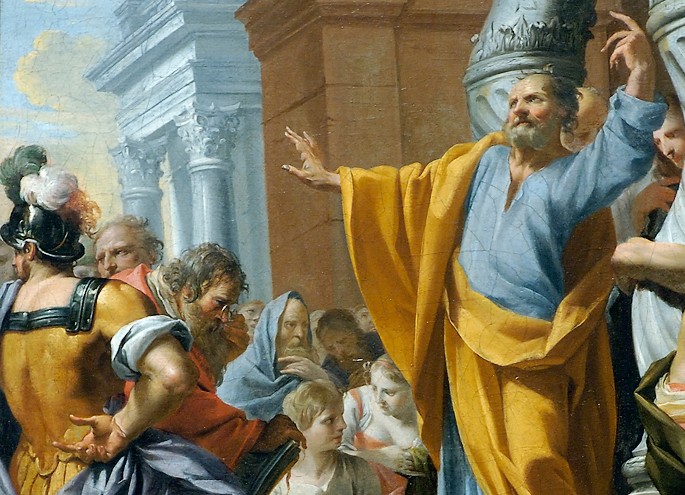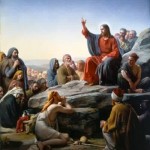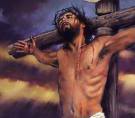“For I delivered to you as of first importance what I also received, that Christ died for our sins in accordance with the scriptures, that he was buried, that he was raised on the third day in accordance with the scriptures” [1 Corinthians 15:3-4].
 St. Peter Preaching in Jerusalem, by Poerson, 1642.
St. Peter Preaching in Jerusalem, by Poerson, 1642.
When Peter, together with the rest of the Eleven, stood up in Jerusalem on the Day of Pentecost, and lifted up his voice to address the people, he did not only give a rousing sermon that caused his audience “to be cut to the heart” and brought some three thousand of them to baptism that very day. He actually gave the best starting point for a lesson on Christology:
“This Jesus whom you crucified, God has raised him up and made him both Lord and Christ” (Acts 2:36).
Peter was a fisherman, not a theologian, but he was privileged to have personally seen, heard, felt and actually journeyed through the excruciating but uplifting life, passion, death and resurrection of his Lord. And now, anointed by the Holy Spirit, he stood up to deliver what in essence was the first post-resurrection Christological formula: Jesus is the Christ. The man called Jesus of Nazareth is the divine personality that came from God – the Messiah for whom generations of Jews have been waiting.
Today, “Jesus Christ” is accepted in common usage as a title and a name. It is in fact neither. It is a theological truth from Peter’s Christological formula – Jesus of Nazareth is the crucified and resurrected Christ!
There is strong agreement in contemporary New Testament scholarship that the resurrection faith preceded the first Christological formulation. Norman Perrin, for example, thinks that the first step taken by the early Church in her theologising was a post-Easter step taken in response to the conviction that Jesus had been raised up by God. When Jesus rose from the dead on Easter Sunday, humanity was given a new lease of life even as it lay in slumber, blissfully unaware that God has wrought changes of cosmic proportions pro nobis – for us, for our good, on account of Christ.
Three points cruise through our minds at this time.
1. Resurrection is affirmation from God
First, is the New Testament use of verb tenses in relation to the Resurrection.
In speaking of Jesus’ resurrection, the New Testament does not use the active tense to speak in terms of Jesus’ self-rising. Rather, Scriptures choose the passive tense – “He was raised on the third day”; “God raised him up”. Another active Agency was involved who conducted the raising of Jesus, and that was God Himself. The significance of this “small” piece of detail is huge. It points definitively to the understanding that Jesus’ fidelity to the Father was not in vain, that his teaching, his entire life and mission and everything that he stood for was pleasing to the Father who saw and affirmed it all as being very good. In the beginning, the Creator God saw everything that He made and said it was good and finally after creating the humans, he saw all He had made and indeed it was “very good” (Genesis 1). Things have gone seriously bad in the mean time. Now, Jesus Christ has made all things new again. The Resurrection of Jesus was a definitive affirmation from God. In raising Jesus from the dead, God intervened in human activities with the clear message that evil and darkness will not have the last word. Goodness and light will ultimately prevail. All this, to be sure, will have immense implications for faithful discipleship.
From Jesus’ first disciples on, therefore, Christian understanding of salvation is freedom that comes through the Cross. Old Testament prophets looked forward to the Cross and the saints of the New Testament looked back to it for guidance. From that perspective flows the important lesson that the freedom of which the Scriptures speak is not the freedom to do whatever we want in life, but the liberty to choose what we ought.
Progress in science and technology has contributed to the difficulty of people living in the twenty-first century to accept the Resurrection as truth and not dismiss it as myth. Questions will continue to be raised as to whether one can come to faith without the Resurrection. The fact is, on that fateful Friday as Jesus breathed His last on Calvary, the centurion stood at the foot of the cross and said, “Truly this man was the Son of God!” (Mark 15:39). Clearly, one can come to some kind of faith without the resurrection. However, that faith would not be complete without resurrection.
The resurrection of Jesus is so central to the Christian faith that St Paul, writing to his first converts in Corinth (1 Cor 15), insisted that if Christ did not rise from the dead, our faith would have been in vain. If our hope in Christ had been for this life only, Paul told all who labour in God’s vineyard, we would be the most pitiful of all people. The fact is, Christ was raised from the dead, “the first fruits of those who have fallen asleep”. Death has lost its sting. Death is no longer the last word. In the end, love wins. So Paul firmly taught that in raising Jesus from the dead, God has begun the process of raising the dead. Be encouraged, be steadfast, Paul tells us. For our faith, our commitment to love God and neighhbour, our work and discipline, the sacrifices we make, shall not be in vain. So Monika Hellwig writes of the resurrection of Jesus as “a sign of God’s compassionate power of the Father vindicating and fulfilling the human self-oblation of Jesus in a transforming radiance of divine splendor and peace which guarantees the meaning and purpose not only of the life and death of Jesus but of all human life and death.” God is faithful; He has proven it in Jesus the Christ. He will do it for us.
2. From mountain to mountain
Second, Resurrection is kingdom-oriented.
What God affirmed in the life and mission of Jesus turns on his kingdom-preaching and kingdom-living.
Mark’s Gospel first portrays Jesus’ kingdom-focus in seven verses and over three veritable catechetical panels: baptism, temptation, and kingdom-preaching (Mark 1:9-15). From baptism in the Jordan, the Spirit drove Jesus into the wilderness to face temptations. Upon emerging victorious against Satan, his sight firmly fixed on kingdom-values, Jesus at once dedicated himself to the task of kingdom-preaching.
From there, Jesus’ life and work testifies that authentic kingdom-preaching is a dangerous thing. It inevitably leads one to the cross. A stunning picture is yielded in reflections when one sees that God affirmed Jesus in the Easter Resurrection because he not only preached the kingdom of God in the great sermon on one mountain, the Sermon on the Mount in Matthew 5-7, but he lived it to the full on another mountain, the mount of Golgotha. In The Passion of the Christ, the artistic brilliance of Mel Gibson, perhaps with advice from his Jesuit theological adviser, came through with a very sound link for theological and spiritual reflection. As Jesus, helped by Simon of Cyrene, reached the foot of Golgotha, he looked up the mountain and right at that point, the cinematic flashback-technique is employed to recall Jesus preaching the great Sermon on the Mount. The idea is theologically stunning: the kingdom-message that he preached on that mountain, will be lived to the full on this mountain. Jesus lived and died for kingdom-building on earth.
[L] Carl Henrich Bloch, The Sermon at the Mount, 1862. [R] Crucified on Mount Golgotha.
From mountain to mountain, we see the significance of whatever Jesus did in relation to the kingdom of God. Theologians and artists alike are acutely aware of the significance of mountains in Jesus’ life. God, after all, is known in the Jewish Scriptures as the El Shadai – God of the Mountain. In Genesis 17:1, YHWH said to Abram: “I am El Shaddai. Walk before me and be perfect.”
3. Practising Resurrection
Third, the resurrection of Jesus establishes the condition in which we live and mature in the Christian life. The only proper response is to practise resurrection. To practise resurrection is to enter into communion with Christ risen, alive and present. That calls for a radical conversion of our human understanding of power and structures. We need to work on liberation at different levels of enslavement, much of which may be the accumulation of unhealthy “tradition” and misplaced self-importance. At the crack of dawn on Easter, Christ had seen to it that a woman would be the first to announce the good news of his resurrection.
Mary Magdalene at the tomb offers three crucial keys for resurrection practices (John 20:1-18). First, we must not run from pain. The Christian journey, modeled after Christ’s Paschal Mystery, is from pain to hope. Second, this Easter hope is not meant for oneself, but for the community at large. Easter is meant to be proclaimed. We practise resurrection by bringing hope to people of pain and hopelessness. We cannot do less than to be the Body of Christ alive in the world. And in the climate of ecclesiastical crisis today, followers of Christ Crucified and Risen must move beyond complaining about the Church we see, and start becoming the Church we dream of. But third, resurrection is the work of God, not the work of humans. In all that we do, our resurrection practices are at their best when they are defined not by our attempts at taking charge and exercising control, but by surrender and trust in God.
This moderating sense comes through in the work of the poet Wendell Berry who coined the phrase “practice resurrection”. We are neither the originators of our lives nor the controllers of our destinies. When we practise resurrection, we enter into what is more than we are. Our companion is Jesus the Christ, who knows where we are going better than we do.
(* This article was written for and originally published in the April 2011 issue of CANews.)
[Postscript: For real life stories of “pain and hope”, please go to our series of five articles beginning 16 September, 2010 on “A Pilgrimage of Pain and Hope – Uganda” posted on this website.]
Copyright © Dr. Jeffrey & Angie Goh, April 2011. All rights reserved.
You are most welcome to respond to this post. Email your comments to us at jeffangiegoh@gmail.com. You can also be dialogue partners in this Ephphatha Coffee-Corner Ministry by sending us questions for discussion.


